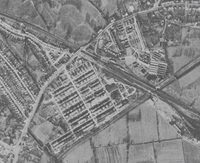RAF West Ruislip
| Royal Air Force West Ruislip | |
|---|---|
| Ickenham, Middlesex | |
 |
|

Aerial view of RAF West Ruislip in 1945 - RAF Blenheim Crescent is to the north-east of the railway line
|
|
| Coordinates | 51°34′7.58″N 000°26′15.80″W / 51.5687722°N 0.4377222°WCoordinates: 51°34′7.58″N 000°26′15.80″W / 51.5687722°N 0.4377222°W |
| Type | Maintenance and administrative |
| Site information | |
| Condition | Demolished |
| Site history | |
| Built | 1917 |
| Built by | American Construction Company |
| Demolished | 2007 |
| Garrison information | |
| Past commanders |
Lieutenant Commander H. Lee (first) |
| Occupants | No. 4 Maintenance Unit (RAF) RAF Records Office Navy Exchange of U.S. Naval Activities, United Kingdom US Navy Morale, Welfare and Recreation Department |
RAF West Ruislip was a Ministry of Defence site, located in Ickenham within the London Borough of Hillingdon. The base was originally built as a depot for the Royal Air Force (RAF), split by what is now the Chiltern Main Line. North of the railway was RAF Blenheim Crescent, which housed the RAF Records Office and the depot's original personnel accommodation.
The site was leased to the US Air Force in 1955, followed by the US Navy in 1975, eventually housing the Navy Exchange of the U.S. Naval Activities, United Kingdom command, and the Navy's Morale, Welfare and Recreation Department.
Following a review of properties, the US Navy vacated the site in 2006 and it became surplus to the Ministry of Defence's requirements under Project MoDEL. The following year, initial plans for around 415 homes and a retirement home were approved by the London Borough of Hillingdon in July 2007. Almost all buildings were subsequently demolished to make way for the new development. Cala Homes bought the 21-acre (85,000 m2) site for £180m in November.
The land upon which the site was developed was originally owned by Edward Hilliard. It was chosen in March 1915 by Wing Commander T. O. Lyons of the Air Ministry to house the Ordnance Aircraft Stores Depot from Farnborough, although a decision was made instead to establish the depot in Didcot, beside the existing buildings there. In 1917, the Ruislip site was revisited, and on 3 July was selected to house a depot for the Royal Flying Corps, under a military acquisition order. The close proximity to the Great Western and Metropolitan Railways made it ideal for the purpose.
Additional construction costs meant the final total was £736,000, up from an original estimate of £235,000. The need for heating brought with it the requirement for boiler houses, plus additional foundations which were needed for the buildings to the north of the railway. Lieutenant J.G.N. Clifts of the Royal Engineers created the design for the site and buildings, and the contractor involved was a U.S. Army civil engineering company, appearing on records as American Construction Company. A temporary railway siding was created to aid in the delivery of building supplies. By 13 December 1918, several sheds had been completed, as were the Officers' Mess, sleeping quarters and the Navy and Army Canteen Board.
...
Wikipedia
